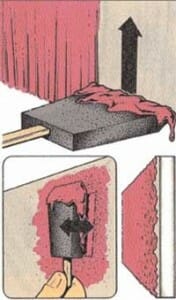
What can you do if you have a wall with flaws so serious that ordinary paint won’t cover them up? Or what if you want a surface with a more tactile quality? Or maybe you want to try for a weathered or stucco look. For any of these, texture painting is a good option. Your Athens painting contractor can give you more in depth information about how you might to use textured paint around your Athens home, whether you are engaging in exterior or interior painting.
Paints specifically designed for texture work are as thick as pancake batter or wet plaster. Some are gritty and some are not. All are ideal for flawed surfaces and for creating a rustic look. You should still wash the surface, scrape off flaking paint, and patch major holes, but you don’t need to make the surface perfectly smooth. Texture paints will camouflage most surface blemishes.
Texture paint without granules in it can be applied with special texturing rollers, a wide brush, a urethane foam brush, or even a trowel. Whatever tool you use, smear the paint onto the surface, about 1/16 inch thick. As with regular wall paint, work with sections approximately three feet square.
Create the surface design in one section at a time. A long-napped texturing roller will give you a uniform stippled effect all over. Similar but less regular stippling can be achieved with a foam brush. Apply the paint, then go over the surface with the flat of the brush, patting the paint to create little peaks and valleys.
You can use less conventional texturing tools once the paint is on the wall, such as crumpled wax paper or a big sponge. With a coarse brush you can create circles or swirls in the paint. Keep the thickness and the texture uniform from one section to another, overlapping their borders as you go along.
For applying grit-textured paint to ceilings, buy a special long-napped roller or use a synthetic-bristle brush. Instructions on the can explain how to apply the paint.
Textured paint can open a whole new world of decorating possibilities for your Athens home.